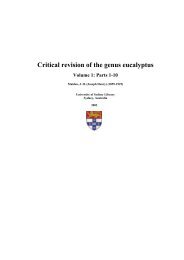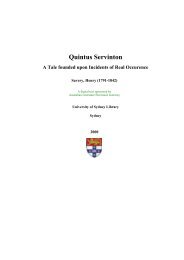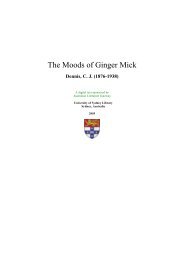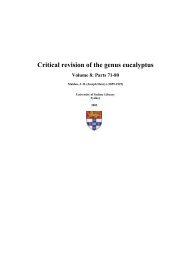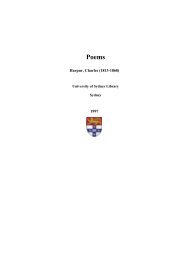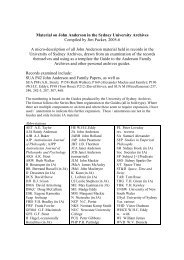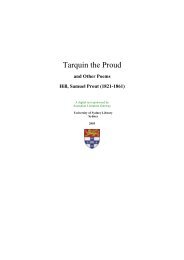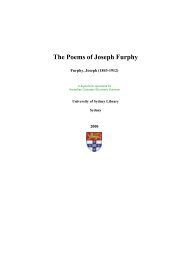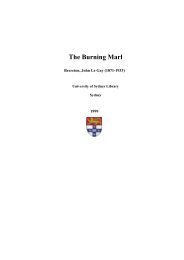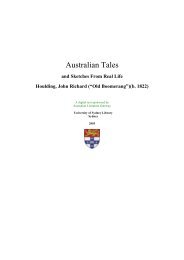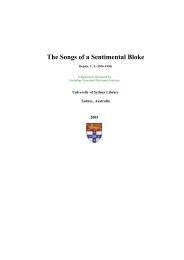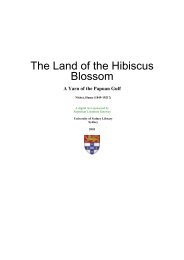- Page 1 and 2: Critical revision of the genus euca
- Page 3 and 4: William Applegate Gullick, Governme
- Page 5 and 6: CCCLII. E. fastigata Deane and Maid
- Page 7 and 8: Oberon Road (F. W. Wakefield, No. 2
- Page 9 and 10: 3. With E. vitrea R. T. Baker. E. f
- Page 11 and 12: 97. Affinities 1. With E. spathulat
- Page 13 and 14: a convenient place to give his comp
- Page 15 and 16: slightly greater width of the leave
- Page 17 and 18: XXVIII. E. virgata Sieb. In Part XX
- Page 19 and 20: LVI. E. Naudiniana F.v.M. The follo
- Page 21 and 22: 35664, Parish Ironbark, County Darl
- Page 23: LXXV. E. falcata Turcz. (Syn. E. Do
- Page 27 and 28: species, but two, viz., E. radiata
- Page 29 and 30: CCIII. E. nitida Hook. f. Syn. E. a
- Page 31 and 32: Enemies of Eucalypts THIS subject i
- Page 33 and 34: in the subject. (Suggestions as to
- Page 35 and 36: L. congener Sieber on E. obtusiflor
- Page 37 and 38: Polyporaceae, and many thousands of
- Page 39 and 40: F. obliquus Cke., S.A., Vict., N.S.
- Page 41 and 42: Coryneum viminale Cke. et Mass. on
- Page 43 and 44: Hand of Man. The deliberate destruc
- Page 45 and 46: Dawsoni. (b) Discontinuous. Bundlin
- Page 47 and 48: aised inflexed ring about 3/4 line
- Page 49 and 50: Explanation of Plates 248-251. Plat
- Page 51 and 52: uds and is not uncommon in the Cory
- Page 53 and 54: Raised lines indicating the shape o
- Page 55 and 56: 6E. E. calophylla. Note the taperin
- Page 57 and 58: (a) Calyx-tube. (b) Calyx-rim. (c)
- Page 59 and 60: (d) Floral disc, with impressions l
- Page 61 and 62: (f) Circular floral disc over the t
- Page 63 and 64: 5B. Operculum from the inside. Note
- Page 65 and 66: absorbing the staminal ring in some
- Page 67 and 68: Part 62
- Page 69 and 70: Near Bendering (257 miles from Pert
- Page 71 and 72: into the pedicel, 6 to 9 mm. long,
- Page 73 and 74: CCCLVII. E. Sargenti n.sp. ARBOR ME
- Page 75 and 76:
ones of those of E. redunca var. el
- Page 77 and 78:
x CCCLVIII. E. Chisholmi Maiden and
- Page 79 and 80:
x CCCLIX. E. Taylori n.sp. Assumed
- Page 81 and 82:
furrowed and harder than that of E.
- Page 83 and 84:
CCVI. E. intermedia R. T. Baker. IN
- Page 85 and 86:
collected in November, 1918. This t
- Page 87 and 88:
Range. Hitherto only found in the S
- Page 89 and 90:
Explanation of Plates 252-255. Plat
- Page 91 and 92:
the calyx. 4b. Vertical section of
- Page 93 and 94:
7d. Capsular disc. (a) Calyx. (b) C
- Page 95 and 96:
Between Gnowangerup and east of Sti
- Page 97 and 98:
(b) Thickness of calyx-tube. (c) Ce
- Page 99 and 100:
(e) Placental column. Hornsby, Sydn
- Page 101 and 102:
(a) Calyx-tube. (b) Thickness of ca
- Page 103 and 104:
14a. Longitudinal section. (a) Caly
- Page 105 and 106:
2d (4) E. rostrata Schlecht. (a) Ca
- Page 107 and 108:
Part 63
- Page 109 and 110:
CLXXV. E. Websteriana Maiden. Two l
- Page 111 and 112:
cream-coloured. In E. nutans there
- Page 113 and 114:
without any appendage, or that of s
- Page 115 and 116:
3.—Vitality of Eucalyptus Seeds.
- Page 117 and 118:
viminalis Labill. 17 100 Nil. vimin
- Page 119 and 120:
in the possession of an aborigine a
- Page 121 and 122:
7.—The Wing. E. microtheca. E. sa
- Page 123 and 124:
(b) The following have a very small
- Page 125 and 126:
allied species which are only sligh
- Page 127 and 128:
Light-brown to dark-brown. E. torqu
- Page 129 and 130:
from 1/2 to 7 mm. broad. Those of E
- Page 131 and 132:
E. crucis, 11/2-2 by 1-2. mm. E. Pe
- Page 133 and 134:
E. Abergiana, 15 mm. (wing included
- Page 135 and 136:
sides, the wing small, usually conc
- Page 137 and 138:
Thicker and with a more concave win
- Page 139 and 140:
Fertile seeds shiny, dark reddish b
- Page 141 and 142:
somewhat wrinkled rugose, or a few
- Page 143 and 144:
E. tessellaris. E. tetragona. E. pa
- Page 145 and 146:
scarcely any ridges. Hilum ventral,
- Page 147 and 148:
Hilum terminal. Sterile seeds light
- Page 149 and 150:
E. occidentalis. “Seeds without a
- Page 151 and 152:
Fertile seeds light to dark brown,
- Page 153 and 154:
White Hope, via Kalgoorlie, Western
- Page 155 and 156:
Explanation of Plates (256-259). In
- Page 157 and 158:
The seeds flat on one side, irregul
- Page 159 and 160:
6b. Enlarged; ventral view of a mor
- Page 161 and 162:
1d. Enlarged; dorsal view of a more
- Page 163 and 164:
11. E. gomphocephala DC., natural s
- Page 165 and 166:
Eucalyptus seed appeared to have co
- Page 167 and 168:
Seeds. Series Striolatae. (conclude
- Page 169 and 170:
and much smaller than the fertile s
- Page 171 and 172:
the depression surrounding it shall
- Page 173 and 174:
Sterile seeds glossy, dark reddish-
- Page 175 and 176:
Boorman, 1918). E. bicolor (as larg
- Page 177 and 178:
E. salmonophloia. “Fertile seeds
- Page 179 and 180:
E. scoparia. Fertile seeds dark bro
- Page 181 and 182:
very concave, the narrow ones curve
- Page 183 and 184:
appendage.” (“Eucalyptographia,
- Page 185 and 186:
surface is totally free from scurfi
- Page 187 and 188:
or less quadrangular, 2-4 mm. long,
- Page 189 and 190:
Boorman, 1916). E. Macarthuri. Fert
- Page 191 and 192:
Larger and more acutely angled than
- Page 193 and 194:
of the capsule are mixed with the s
- Page 195 and 196:
Fertile seeds dull, light brown, 11
- Page 197 and 198:
over, slightly wrinkled, the edges
- Page 199 and 200:
Sterile seeds 4-6 mm. long, red-bro
- Page 201 and 202:
Sterile seeds glossy, light to dark
- Page 203 and 204:
E. regnans. E. Moorei. E. Laseroni.
- Page 205 and 206:
or three sharp ridges, the back con
- Page 207 and 208:
mm. broad, somewhat obliquely pyram
- Page 209 and 210:
smooth, minutely pitted back, the f
- Page 211 and 212:
Sterile seeds glossy, reddish-brown
- Page 213 and 214:
polymorphic, D-shaped, pyramidal to
- Page 215 and 216:
more numerous than the narrow ones,
- Page 217 and 218:
Fertile seeds light to dark brown,
- Page 219 and 220:
Sterile seeds glossy, somewhat simi
- Page 221 and 222:
5.a Enlarged, showing the ventral s
- Page 223 and 224:
15a. Enlarged, showing the smooth v
- Page 225 and 226:
Plate 261: Seeds: EUCALYPTUS PERRIN
- Page 227 and 228:
11c. Enlarged, showing the ventral
- Page 229 and 230:
SMITHII R. T. Baker. (5). E. MACART
- Page 231 and 232:
12b. Enlarged, showing the ventral
- Page 233 and 234:
2f. Enlarged, showing the ventral s
- Page 235 and 236:
Australia, J.H.M., 1909.) 13. E. bu
- Page 237 and 238:
VI. The Leaf. (With special referen
- Page 239 and 240:
Average range—50 to 65 degrees. E
- Page 241 and 242:
Part LII of this work, p. 89. BRIOS
- Page 243 and 244:
E. eugenioides, figs. 1-2, Plate 39
- Page 245 and 246:
“Leaves often 5 inches long by 4
- Page 247 and 248:
3. E. calycogona Turcz. Very glauco
- Page 249 and 250:
165. E. dealbata A. Cunn. With long
- Page 251 and 252:
almost at right angles to the midri
- Page 253 and 254:
length and 4 cm. in width, the intr
- Page 255 and 256:
18. E. Muelleriana Howitt. Sessile,
- Page 257 and 258:
midrib, the intramarginal vein dist
- Page 259 and 260:
making an angle of about 40 to 50 d
- Page 261 and 262:
193. E. tessellaris F.v.M. Shortly
- Page 263 and 264:
thin, devoid of hairs, not perfolia
- Page 265 and 266:
4c. Enlarged, showing the ventral s
- Page 267 and 268:
2. E. capitellata, natural size. 2a
- Page 269 and 270:
13d. Enlarged, showing the ventral
- Page 271 and 272:
27b. Enlarged, sterile seed. Plate
- Page 273 and 274:
Part 66
- Page 275 and 276:
sea-coast and the South Australian
- Page 277 and 278:
W3. 36 6 W4. 88 3 K1. 33 9 K2. 11 1
- Page 279 and 280:
W.3. W.3, W.4. W.3, W.4, S.1. W.3,
- Page 281 and 282:
S.2, Q.3, N.2, V S.2, Q.3, N.2, V,
- Page 283 and 284:
Q.3, N.2, V. Q.3, N.2, V, T. globul
- Page 285 and 286:
W.2. W.3. W.4. caesia. gamophylla.
- Page 287 and 288:
K.2. S.1. S.2. Q.1. latifolia tetro
- Page 289 and 290:
N.1. Banksii. globulus Baueriana. g
- Page 291 and 292:
V. crebra. numerosa. Dalrympleana.
- Page 293 and 294:
Andrewsi 1 1 angophoroides 1 angulo
- Page 295 and 296:
dives 1 1 Dongarraensis 1 doratoxyl
- Page 297 and 298:
Macarthuri 1 macandra 1 macrocarpa
- Page 299 and 300:
adiata 1 1 rariflora 1 Ravereliana
- Page 301 and 302:
Victoria 68 Tasmania 25 New South W
- Page 303 and 304:
confluens 1 conglobata 1 1 conica 1
- Page 305 and 306:
Irbyi 1 Isingiana 1 Jacksoni 1 Jens
- Page 307 and 308:
patellaris 1 patens 1 Peacockeana 1
- Page 309 and 310:
TROPICAL SPECIES. The tropical area
- Page 311 and 312:
some North and South Queensland spe
- Page 313 and 314:
18. pachyphylla F.v.M. 27. oleosa F
- Page 315 and 316:
A. Herbert (late of Western Austral
- Page 317 and 318:
for a year or two, after which it e
- Page 319 and 320:
growth is slow. It stands a heavy r
- Page 321 and 322:
edge of the “Never-Never Country,
- Page 323 and 324:
New South Wales.—“97 mile-post
- Page 325 and 326:
further north than Grant Range and
- Page 327 and 328:
Specific localities are sandy hills
- Page 329 and 330:
Mr. R. T. Baker records it (under t
- Page 331 and 332:
Mount Dagleish, extending south-eas
- Page 333 and 334:
decussata. 53. E. melanophloia F.v.
- Page 335 and 336:
73. E. oleosa F.v.M. (“A Red Morr
- Page 337 and 338:
the branches brittle; the timber is
- Page 339 and 340:
central district, and as far north
- Page 341 and 342:
South Australia.—See Part XXVII,
- Page 343 and 344:
in a stony creek near the station.
- Page 345 and 346:
210. E. transcontinentalis Maiden.
- Page 347 and 348:
them “intermediate leaves.” I a
- Page 349 and 350:
surfaces a dark, glossy green, 11 t
- Page 351 and 352:
nearly every alternate pair of leav
- Page 353 and 354:
E. macandra 36 177 150 3a E. maculo
- Page 355 and 356:
Explanation of Plates (268-271). Pl
- Page 357 and 358:
Part 67
- Page 359 and 360:
Range Confined to southern Queensla
- Page 361 and 362:
Papers on Range or Distribution. A
- Page 363 and 364:
2. The Great Plains, extending from
- Page 365 and 366:
species, the Stirling district not
- Page 367 and 368:
gomphocephala E. patens, E. salmono
- Page 369 and 370:
Conference, London, 1920. The most
- Page 371 and 372:
Dieman's Land and New South Wales .
- Page 373 and 374:
Wales (Proc. Linn. Soc., N.S.W., XX
- Page 375 and 376:
2. “Lectures on the Vegetable Kin
- Page 377 and 378:
II. From Cobar to the Bogan River a
- Page 379 and 380:
(Xanthorrhaea),” &c. (p. 67). “
- Page 381 and 382:
Factors Which Influence Range or Di
- Page 383 and 384:
Kosciusko. The trees at the highest
- Page 385 and 386:
Divide, serves to show that the two
- Page 387 and 388:
supposed. He says that E. regnans,
- Page 389 and 390:
viminalis). The flat clayey and gra
- Page 391 and 392:
“Some Notes on the Soils and Fore
- Page 393 and 394:
Ash, Ironbark (E. decorticans), Str
- Page 395 and 396:
Gum (E. alba), and on moist flats,
- Page 397 and 398:
with the coastal laterites. The veg
- Page 399 and 400:
Age and Area. By way of introductio
- Page 401 and 402:
Species,” by Hugo de Vries, Journ
- Page 403 and 404:
leaves remain clasping the stem at
- Page 405 and 406:
217. E. dichromophloia F.v.M. Leave
- Page 407 and 408:
Following is a translation of Hooke
- Page 409 and 410:
Explanation of Plates (272-275). Pl
- Page 411 and 412:
8. Mature leaf. Cox's River, New So
- Page 413 and 414:
E. Bloxsomei Maiden, n.sp. 1a. Twig
- Page 415 and 416:
CCCLXIII. E. Dwyeri, Maiden and Bla
- Page 417 and 418:
quantity of E. trachyphloia growing
- Page 419 and 420:
CCCLXIV. E. Burracoppinensis, Maide
- Page 421 and 422:
Burracoppinensis.
- Page 423 and 424:
not very well developed. The name p
- Page 425 and 426:
forming a thin, dark carnose lining
- Page 427 and 428:
CCCLXVII. E. Staerii Maiden. In Jou
- Page 429 and 430:
CCCLXVIII. E. Badjensis, de Beuzevi
- Page 431 and 432:
E. Bauerleni, but as the juvenile l
- Page 433 and 434:
This species has been found only in
- Page 435 and 436:
slender, spirally twisted at the to
- Page 437 and 438:
species or were themselves hybrids
- Page 439 and 440:
immediately surrounding it was E. m
- Page 441 and 442:
Science, xiii, 237 (1912), of the F
- Page 443 and 444:
E. drepanophylla, E. crebra, E. ter
- Page 445 and 446:
globulus, E. urnigera, E. viminalis
- Page 447 and 448:
E. pilularis var. ? acmenioides. TO
- Page 449 and 450:
into under the species. It might be
- Page 451 and 452:
official recipients of scientific s
- Page 453 and 454:
B.—the Value of the Study of Euca
- Page 455 and 456:
Research Council,” Journ. Amer. P
- Page 457 and 458:
E. Whitei Maiden and Blakely. 4a. J
- Page 459 and 460:
Part 69
- Page 461 and 462:
CCCXXXIII. E. rigidula, n.sp. Synon
- Page 463 and 464:
the calyx-tube. Anthers opening in
- Page 465 and 466:
CCXV. E. terminalis F.v.M. var. nov
- Page 467 and 468:
to by the fact that the trees have
- Page 469 and 470:
CCCLXXIII. E. cylindriflora Maiden
- Page 471 and 472:
CCCLXXIV. x E. Westoni Maiden and B
- Page 473 and 474:
CCCLXXV. E. microneura Maiden and B
- Page 475 and 476:
CLXX. E. Dundasi Maiden. In Crit. R
- Page 477 and 478:
LXXXIV. E. diptera Andrews. See Par
- Page 479 and 480:
CCCLXXVI. E. ovularis Maiden and Bl
- Page 481 and 482:
CCCLXXVII. E. Kesselli Maiden and B
- Page 483 and 484:
CCCLXXVIII. E. Desmondensis Maiden
- Page 485 and 486:
LXXXIV. E. aggregata Deane and Maid
- Page 487 and 488:
LXXII. E. Forrestiana Diels. See Cr
- Page 489 and 490:
tube to the slightly raised stamina
- Page 491 and 492:
The Species Question. 1. WHAT IS A
- Page 493 and 494:
xxvi, 801, 1901.) 4. NO FIXED LINE
- Page 495 and 496:
essentially you are working in limi
- Page 497 and 498:
forms depicted may possibly be pref
- Page 499 and 500:
taxonomists and non-botanists often
- Page 501 and 502:
Nomenclature,’ in Bull. Torrey Bo
- Page 503 and 504:
FLORA OF NEW SOUTH WALES.” Botani
- Page 505 and 506:
Some Aphorisms. Huxley (“Life,”
- Page 507 and 508:
Explanation of Plates 280-283. Plat
- Page 509 and 510:
Australia (C. A. Gardner, Western A
- Page 511 and 512:
Part 70
- Page 513 and 514:
The type specimen of the former doe
- Page 515 and 516:
Grampians at p. 455. 2. Juvenile le
- Page 517 and 518:
with conical operculum, and some wi
- Page 519 and 520:
those of E. capitellata. Adult leav
- Page 521 and 522:
CCLVII. E. Blaxlandi Maiden and Cam
- Page 523 and 524:
CCCLXXXI. E. orgadophila, Maiden an
- Page 525 and 526:
XXVI. E. acmenioides Schau. var. te
- Page 527 and 528:
within the orifice. The name Murphy
- Page 529 and 530:
of some of the large forms and of v
- Page 531 and 532:
CCLXII. E. angophoroides R. T. Bake
- Page 533 and 534:
Cotyledons (See Plates 286, 287). A
- Page 535 and 536:
1. Vernacular Names. Perusal of the
- Page 537 and 538:
Ruskinian extracts, what a fool the
- Page 539 and 540:
the nomenclature of Eucalyptus cann
- Page 541 and 542:
to render the definition of a speci
- Page 543 and 544:
might have Red Ironbark and Pale Ir
- Page 545 and 546:
capable of identification, will be
- Page 547 and 548:
E. Cloeziana on the Upper May River
- Page 549 and 550:
E. Murphyi Maiden and Blakely, n. s
- Page 551 and 552:
cotyledons are all reniform, and ra
- Page 553 and 554:
6a, 6b. E. eugenioides, Wingello, N
- Page 555 and 556:
Series 20. Narrow, semi-rigid. The
- Page 557:
Hypocotyl slender, cotyledons deepl



